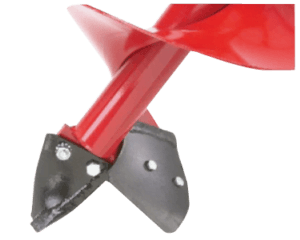Whether you’re a DIY’er looking to complete one simple backyard project or a contractor tackling customer jobs, choosing the correct drill type and auger for a project significantly increases the ease and efficiency of your drilling job. Let’s explore which choices are the best for your project.
Mechanical or Hydraulic?
 Depending on the project, you might find that a mechanical earth drill performs better than a hydraulic earth drill. However, the best option comes down to a few different factors including borehole diameter, soil type and maneuverability needs.
Depending on the project, you might find that a mechanical earth drill performs better than a hydraulic earth drill. However, the best option comes down to a few different factors including borehole diameter, soil type and maneuverability needs.
Our Mechanical Earth Drills are ideal for drilling relatively small holes, ranging from 1.5 to 12-inch diameters, in sandy or loamy soil profiles. You might use this drill for landscaping, erecting signs or installing fence posts. DIY’ers often find the Mechanical Earth Drill to be the superior option for home improvement projects. With additional kits, these drills extend past simple post hole drilling. Little Beaver Mechanical Earth Drills offer the option to pair with a horizontal boring kit to bore up to 50 feet under driveways, sidewalks and parking lots.
 Our Hydraulic Earth Drills have twice the torque of our mechanical models, which makes them better for tasks demanding larger holes up to 16 inches. This could include projects like building a pole barn or monitoring groundwater. These high-powered machines are optimal for use in frozen soil, clay and rocky sediments.
Our Hydraulic Earth Drills have twice the torque of our mechanical models, which makes them better for tasks demanding larger holes up to 16 inches. This could include projects like building a pole barn or monitoring groundwater. These high-powered machines are optimal for use in frozen soil, clay and rocky sediments.
Both earth drill options feature compact, lightweight designs that give them a small footprint and allow them to reach areas where larger models and skid steers can’t go.
Hydraulic Earth Drills can take mobility one step further. Our Towable Earth Drill conveniently attaches to a trailer hitch for hauling to and from the jobsite while the UN-Towable can fit in the back of most SUVs and pickup trucks. They’re also able to drill right next to buildings and other structures. For the toughest jobs, we offer the Big Beaver. Rental centers often choose to stock both mechanical and hydraulic earth drills to appeal to a wider audience of users, including DIY’ers and contractors.
Selecting an Auger
 Auger selection can be just as important as drill selection. Roughly 80% of projects will use a standard auger with standard points and blades, which work best in loamy, sandy soil profiles. Typically, these augers range in size between 1.5 to 16 inches, reaching depths of up to 36 inches. Some manufacturers offer additional points and blades that help to expand the use of the standard auger. For example, a carbide blade is best for the toughest types of ground, such as asphalt, dense clay and frozen dirt.
Auger selection can be just as important as drill selection. Roughly 80% of projects will use a standard auger with standard points and blades, which work best in loamy, sandy soil profiles. Typically, these augers range in size between 1.5 to 16 inches, reaching depths of up to 36 inches. Some manufacturers offer additional points and blades that help to expand the use of the standard auger. For example, a carbide blade is best for the toughest types of ground, such as asphalt, dense clay and frozen dirt.
When there’s harsh, rocky terrain underfoot, you need an equally rugged auger. Heavy-duty augers are designed with features like larger flighting and tougher cutting blades. Little Beaver also has heavy-duty points and blades to slice through harder ground, like gravel.
To choose the best auger for your project, it’s important to understand the terrain you will be drilling in. It’s also important to recognize if you’re going to be using the same drill for more than one project. While a post hole might be drilled in an area with loamy soil, a sign might be installed in harsher soil conditions, which will require different auger types and, possibly, different auger diameters.
Making the Best of Your Project
Little Beaver offers an expansive library of informational resources to help you make your project a success. In the FAQ section of our website, you can find detailed answers to questions that may arise as you drill deeper into a project. We’re also happy to have you contact us directly by email or phone.